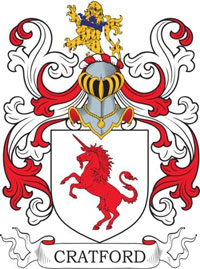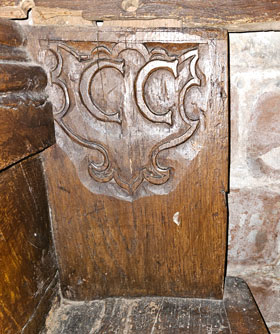About 1561 the Dean and Chapter leased the site of the manor to John Cratford and his daughters Elizabeth and Joan for, £8 14s. 4d., and the third and tenth sheaf of corn growing on the arable land, these sheaves being afterwards commuted for £2 l0s. 10d. After John's death his daughter Joan wife of William Doughtie instituted proceedings to recover the property, which had been seized by her kinsman John Cratford, son of Humphrey Cratford of Croome, co. Worcester, and by her sister Elizabeth wife of Richard Whitney. It does not appear whether she was successful, but in 1636 Charles Cratford obtained from the dean and chapter a lease of the farm of the manor. Cratford was indicted about 1618-19 for an alleged tampering with a book containing the assessment of lands in the parish and the rules and customs to guide the parishioners. He was then said to have come into the parish six years previously.
The prior and monks of Worcester acquired several pieces of land and rents in the parish during the 13th century. John de la Pulle sold to the prior and monks Lutle forlonge with a messuage above Holeweie, for which he paid yearly 4d. The deed of sale is undated, but it was probably before 1240, as the register of the priory of that date records the fact that Brother Ralph had bought one messuage from John de la Pulle. Hugh the son of Siward, with the consent of Cecily his wife, released to the prior all his lands in Broadwas, in return for which the prior gave him 30 marks of silver. The prior also acquired land of Adam de Ancredham. Richard Habington, grandfather of Thomas Habington, the Worcestershire historian, owned property in Broadwas about which there were Chancery proceedings in the middle of the 16th century. Nash writing at the end of the 18th century, deplored the state of the farms at Broadwas in spite of the good quality of the soil, but the estates, he says, are held by lives under the church, and the fields belonging to the several farms very much dispersed, they are not so much improved as they might be.Cratford, Charles, of co. Worcester, pleb. Balliol Coll., matric 14 Oct., 1596, aged 18; B.A. 31 May, 1600.
Cratford, Christopher, born in Oxon, s. Charles, of Broadwas, co. Worcester, gent Balliol Coll., matric. 15 May, 1640, aged 18.
In 1634 Charles Cratford, who described himself as of Broadwas and Claines, entered his arms at the Heralds’ Visitation of Worcestershire; and in 1636 obtained from the Chapter a renewal of the lease of Broadwas.
A monument in the church records, that Elizabeth wife of Charles Cratford was buried there in 1623.
Elizabeth was daughter of •Dr. Anthony Gate, master of University College, Oxon: Charles Cratford her husband entered his pedigree at the visitation of Worcestershire, 1634. (C. 30 f. 105. in Coll. arm.)
Reference: STAC 8/302/14
Description:
Short title: Whitney v Cratforde.
Plaintiffs: Humphrey Whitney, gent, grandson of John Cratforde, deceased.
Defendants: Humphrey Cratforde, brother of the said John Cratforde, and Charles Cratforde.
Subject: Forgery of an assignment of a lease of the manor of Broadwas in the name of William Cratforde another brother, lessee to uses.
Worcestershire.
Another action was also brought before the Chancery.
Barnes category: forgery.
Date: 1610 FebReference: STAC 8/87/19
Short title: Cratford v Cratford.
Plaintiffs: William Cratford gent of Bromhall.
Defendants: Charles Cratford gent of Claines, Richard Pearce, Edward Cotes, and others.
Subject: Forcible entry, driving of cattle and assault on the servant of plaintiff William Cratford at Broadwas.
Worcestershire.
Barnes category: assault; destruction of property; unlawful assembly
Date: 1612 June
•Anthony Gate was an Oxford academic and administrator. He was Fellow and Master of University College, Oxford.
At Oxford University, Gate took his MA degree in 1572 and his B.Med. (his highest degree, in medicine) in 1580. He was the first layman to be elected Master of University College. He took office on 15 September 1584, after William James resigned to become Dean of Christ Church. There would not be another layman as Master of the College until Reginald Walter Macan in 1906, so this was an unusual choice for the time.
Gate was married to Judith. They lived in the Lodgings and his four sons (Peter, Nathaniel, Timothy, and Thomas) all attended University College for their education.•Anthony Gate appears to have spent all his academic life as a member of University College. He took his B.A. in 1568/9, and his M.A. in 1572, and is recorded as renting a room in the College from 1573/4-1583/4. When he was elected Master of the College in 1584, he was the first, and (until the 20th century) the only layman to take up this post. He died in office in 1597.
©peh


